That vs. Which: What’s the Difference?
Updated: Aug. 30, 2023
This rule, *which* confuses a lot of people, has to do with the overall meaning of the sentence.

As grammar rules go, the difference between “that” and “which” is far from the most contentious. It’s not the Oxford comma, using a preposition to end a sentence. But there’s still a chance that you’ve been using these two very common words incorrectly.
When does the confusion arise?
Of course, you know to say “I don’t know which one to choose!” and “I decided to go with that one.” The confusion comes when you’re using them to introduce a clause because you use them at precisely the same spot in the sentence to mean somewhat the same thing. For instance, would you say “The car that I just bought is green” or “The car which I just bought is green”? Technically, you could correctly write either of those sentences, but the use of “that” or “which” changes the sentence’s meaning.
Here’s the rule: “That” indicates a defining clause, while “which” indicates a non-defining clause. To understand the difference between “that” and “which,” we need to understand the difference between defining and non-defining clauses, which admittedly isn’t a common staple of grammar knowledge. A clause is “defining” when the meaning of the sentence changes when it isn’t there. A non-defining clause, meanwhile, could be taken out of the sentence without changing its meaning. Let’s use the car example to explain the difference. Here’s when you should use flush out or flesh out.
Examples of non-defining and defining clauses
Imagine writing “The car which I just bought is green.” First and foremost, you’d want to add commas to the sentence to make it, “The car, which I just bought, is green.” Non-descriptive clauses, using “which,” often have commas around them, another helpful way to distinguish the two. In this sentence, “which I just bought” is nonessential to the meaning of the sentence. The point of the sentence is that the car is green; the fact that you just bought it is a superfluous detail. Compare that with “The car that I just bought is green.” The use of “that” makes it a restrictive cause and implies that you have more than one car. Therefore, you need the clause “that I just bought” to clarify which car you’re talking about.
Consider this example, too. In the sentence “We ate the cookies, which Sarah made, in less than an hour,” the fact that Sarah made the cookies doesn’t change the meaning of the sentence. But in this sentence—”We liked the cookies that Sarah made better than the store-bought ones”—”that Sarah made” is an essential descriptor of the cookies because the sentence also talks about different cookies. It can be confusing, all right, making it one of the most confusing grammar rules in English.
How strict is this rule?
Merriam-Webster admits that the use of “which” in non-defining clauses isn’t grammatically imperative. Most people probably wouldn’t blink an eye at “We ate the cookies that Sarah made in less than an hour,” even though “that Sarah made” isn’t essential to the sentence. The reverse rule, though, is a little stricter; use “that” instead of “which” in a defining clause. For instance, “We liked the cookies which Sarah made better than the store-bought ones” comes across as a little grammatically funky.
And we know what you’re thinking—yes, many people just take the pronoun out completely. “We ate the cookies Sarah made in less than an hour.” “We liked the cookies Sarah made better than the store-bought ones.” Though it’s not the most polished grammar, every English speaker has probably done it at some point, and your meaning will likely still come across! And that’s not the only grammar rule you’re probably safe ignoring—here are 10 more.
